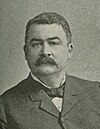| Member | Party | Years | Cong
ress | Electoral history |
|---|
| District created March 4, 1863 |

James S. Rollins
(Columbia) | Union | March 4, 1863 –
March 3, 1865 | 38th | Redistricted from the 2nd district and re-elected in 1862.
Retired. |
George W. Anderson
(Louisiana) | Republican | March 4, 1865 –
March 3, 1869 | 39th
40th | Elected in 1864.
Re-elected in 1866.
Retired. |

David P. Dyer
(Louisiana) | Republican | March 4, 1869 –
March 3, 1871 | 41st | Elected in 1868.
Lost re-election. |

Andrew King
(St. Charles) | Democratic | March 4, 1871 –
March 3, 1873 | 42nd | Elected in 1870.
Retired. [2] |

Isaac C. Parker
(St. Joseph) | Republican | March 4, 1873 –
March 3, 1875 | 43rd | Redistricted from the 7th district and re-elected in 1872.
Retired. |

David Rea
(Savannah) | Democratic | March 4, 1875 –
March 3, 1879 | 44th
45th | Elected in 1874.
Re-elected in 1876.
Lost re-election. |

Nicholas Ford
(Rochester) | Greenback | March 4, 1879 –
March 3, 1883 | 46th
47th | Elected in 1878.
Re-elected in 1880.
Lost re-election. |

James Broadhead
(St. Louis) | Democratic | March 4, 1883 –
March 3, 1885 | 48th | Elected in 1882.
Retired. |

John M. Glover
(St. Louis) | Democratic | March 4, 1885 –
March 3, 1889 | 49th
50th | Elected in 1884.
Re-elected in 1886.
Retired to run for governor. |

Nathan Frank
(St. Louis) | Republican | March 4, 1889 –
March 3, 1891 | 51st | Elected in 1888.
Retired. |

Seth W. Cobb
(St. Louis) | Democratic | March 4, 1891 –
March 3, 1893 | 52nd | Elected in 1890.
Redistricted to the 12th district . |

Champ Clark
(Bowling Green) | Democratic | March 4, 1893 –
March 3, 1895 | 53rd | Elected in 1892.
Lost re-election. |

William M. Treloar
(Mexico) | Republican | March 4, 1895 –
March 3, 1897 | 54th | Elected in 1894.
Lost re-election. |

Champ Clark
(Bowling Green) | Democratic | March 4, 1897 –
March 2, 1921 | 55th
56th
57th
58th
59th
60th
61st
62nd
63rd
64th
65th
66th | Elected in 1896.
Re-elected in 1898.
Re-elected in 1900.
Re-elected in 1902.
Re-elected in 1904.
Re-elected in 1906.
Re-elected in 1908.
Re-elected in 1910.
Re-elected in 1912.
Re-elected in 1914.
Re-elected in 1916.
Re-elected in 1918.
Lost re-election and died before next term. |
| Vacant | March 2, 1921 –
March 3, 1921 | 66th | |

Theodore W. Hukriede
(Warrenton) | Republican | March 4, 1921 –
March 3, 1923 | 67th | Elected in 1920.
Lost re-election. |

Clarence Cannon
(Elsberry) | Democratic | March 4, 1923 –
March 3, 1933 | 68th
69th
70th
71st
72nd | Elected in 1922.
Re-elected in 1924.
Re-elected in 1926.
Re-elected in 1928.
Re-elected in 1930.
Redistricted to the at-large district . |
| District inactive | March 4, 1933 –
January 3, 1935 | 73rd | All representatives elected at-large. |

Clarence Cannon
(Elsberry) | Democratic | January 3, 1935 –
May 12, 1964 | 74th
75th
76th
77th
78th
79th
80th
81st
82nd
83rd
84th
85th
86th
87th
88th | Redistricted from the at-large district and re-elected in 1934.
Re-elected in 1936.
Re-elected in 1938.
Re-elected in 1940.
Re-elected in 1942.
Re-elected in 1944.
Re-elected in 1946.
Re-elected in 1948.
Re-elected in 1950.
Re-elected in 1952.
Re-elected in 1954.
Re-elected in 1956.
Re-elected in 1958.
Re-elected in 1960.
Re-elected in 1962.
Died. |
| Vacant | May 12, 1964 –
November 3, 1964 | 88th | |

William L. Hungate
(Troy) | Democratic | November 3, 1964 –
January 3, 1977 | 88th
89th
90th
91st
92nd
93rd
94th | Elected to finish Cannon's term.
Re-elected in 1964.
Re-elected in 1966.
Re-elected in 1968.
Re-elected in 1970.
Re-elected in 1972.
Re-elected in 1974.
Retired. |

Harold Volkmer
(Hannibal) | Democratic | January 3, 1977 –
January 3, 1997 | 95th
96th
97th
98th
99th
100th
101st
102nd
103rd
104th | Elected in 1976.
Re-elected in 1978.
Re-elected in 1980.
Re-elected in 1982.
Re-elected in 1984.
Re-elected in 1986.
Re-elected in 1988.
Re-elected in 1990.
Re-elected in 1992.
Re-elected in 1994.
Lost re-election. |

Kenny Hulshof
(Columbia) | Republican | January 3, 1997 –
January 3, 2009 | 105th
106th
107th
108th
109th
110th | Elected in 1996.
Re-elected in 1998.
Re-elected in 2000.
Re-elected in 2002.
Re-elected in 2004.
Re-elected in 2006.
Retired to run for governor. |

Blaine Luetkemeyer
(St. Elizabeth) | Republican | January 3, 2009 –
January 3, 2013 | 111th
112th | Elected in 2008.
Re-elected in 2010.
Redistricted to the 3rd district . |
| District eliminated January 3, 2013 |


















